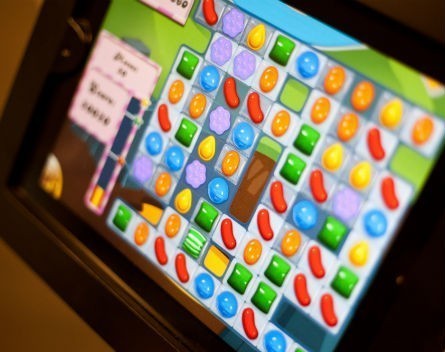
Walk through any public area and you’ll see people glued to their phones, playing mobile games like Game of War and Candy Crush Saga. They aren’t alone. 59% of Americans play video games, and contrary to stereotypes, 48% of gamers are women. The US$100 billion video game industry is among the least-appreciated business phenomena in the world today.
But this isn’t an article about video games. It’s about where innovative organizations are applying the techniques that make those games so powerfully engaging: everywhere else.
Gamification is the perhaps-unfortunate name for the growing practice of applying structural elements, design patterns, and psychological insights from game design to business, education, health, marketing, crowdsourcing and other fields. Over the past four years, gamification has gone through a cycle of (over-)hype and (overblown) disappointment common for technological trends. Yet if you look carefully, you’ll see it everywhere.
Tapping into pieces of games
Gamification involves two primary mechanisms. The first is to take design structures from games, such as levels, achievements, points, and leaderboards — in my book, For the Win, my co-author and I label them “game elements” — and incorporate them into activities. The second, more subtle but ultimately more effective, is to mine the rich vein of design techniques that game designers have developed over many years. Good games pull you in and carry you through a journey that remains engaging, using an evolving balance of challenges and a stream of well crafted, actionable feedback.
Many enterprises now use tools built on top of Salesforce.com’s customer relationship management platform to motivate employees through competitions, points and leaderboards. Online learning platforms such as Khan Academy commonly challenge students to “level up” by sprinkling game elements throughout the process. Even games are now gamified: Microsoft’s Xbox One and Sony’s PS4 consoles offer a meta-layer of achievements and trophies to promote greater game-play.
The differences between a gamified system that incorporates good design principles and one that doesn’t aren’t always obvious on the surface. They show up in the results.
Duolingo is an online language-learning app. It’s pervasively and thoughtfully gamified: points, levels, achievements, bonuses for “streaks,” visual progression indicators, even a virtual currency with various ways to spend it. The well integrated gamification is a major differentiator for Duolingo, which happens to be the most successful tool of its kind. With over 60 million registered users, it teaches languages to more people than the entire US public school system.
Most of the initial high-profile cases of gamification were for marketing: for example, USA Network ramped up its engagement numbers with web-based gamified challenges for fans of its shows, and Samsung gave points and badges for learning about its products.
Soon it became clear that other applications were equally promising. Today, organizations are using gamification to enhance employee performance, promote health and wellness activities, improve retention in online learning, help kids with cancer endure their treatment regimen, and teach people how to code, to name just a few examples. Gamification has potential anywhere that motivation is an important element of success.
Gamification harnesses innate drives
Gamification works because our responses to games are deeply hard-wired into our psychology. Game design techniques can activate our innate desires to recognize patterns, solve puzzles, master challenges, collaborate with others, and be in the drivers’ seat when experiencing the world around us. They can also create a safe space for experimentation and learning. After all, why not try something new when you know that even if you fail, you’ll get another life?
The surface dimension of gamification is motivation through rewards: Earn some points, top the leaderboard, get a badge, win a prize and repeat. Behaviorists such as the legendary B F Skinner called this operant conditioning, and it does work … to a point. If there’s really no point to the points, users lose interest. That’s apparently what happened to marketing-driven Samsung Nation, one of the most prominent early gamification examples. Today it’s nowhere to be found on the Samsung website.
Shallow gamification can even be harmful, if it’s used to manipulate people toward results that aren’t truly in their interest, or if it suggests that rewards are the only reason to do otherwise intrinsically engaging activities.
The systems that avoid these pitfalls take games seriously. In a good game, the points and the leaderboards aren’t what really matter; the true reward is the journey. Gamification systems that emphasize progression, provide well designed informational feedback, and look for ways to surprise and delight their players can remain engaging for the long haul.
It’s still early in the development of gamification as a business practice. In the next stage, expect gamification features to be incorporated more consistently into software and content platforms, the way social media capabilities are today. And look for systems to take advantage of the wealth of behavioral data from user interactions to refine their effectiveness, as online games have done for years. The next person you see glued to their phone or their computer screen just might be learning or doing their job .
![]()
This article was originally published on The Conversation. Read the original article.
Follow StartupSmart on Facebook, Twitter, and LinkedIn. Buy tickets to the 2015 StartupSmart Awards.


COMMENTS
SmartCompany is committed to hosting lively discussions. Help us keep the conversation useful, interesting and welcoming. We aim to publish comments quickly in the interest of promoting robust conversation, but we’re a small team and we deploy filters to protect against legal risk. Occasionally your comment may be held up while it is being reviewed, but we’re working as fast as we can to keep the conversation rolling.
The SmartCompany comment section is members-only content. Please subscribe to leave a comment.
The SmartCompany comment section is members-only content. Please login to leave a comment.